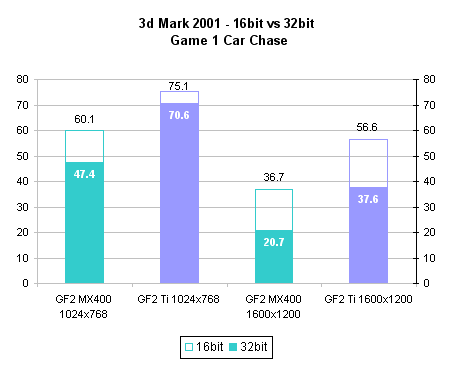|
Performance
Comparison
The
Geforce2 MX400 vs. The Geforce2 Ti
by Mark
Rubrico

16
bit vs. 32 bit Performance
Full
Screen Anti-Aliasing is very playable with the MX400
on 16 bit mode. The difference ( frame rate ) of the
32 bit and 16 bit FSAA ( and non-FSAA )modes however
have not been presented in detail. Instead of having
to compare one chart to another, combining both graphs
that shows the performance of both modes ( 16bit and
32bit ) side by side would make it easier "visualize"
the performance delta.

We start
off with Quake 3 with several different resolutions.
The solid
bar represents the 32bit performance, while the 16bit
performance is represented by the clear bar. Also, the
purple bars represents the Geforce2 Ti's performance
and the the teal ones belong to the MX400.
At 640x480
switching to 16 bit boosts the MX400's frame rate by
20% The Geforce2 Ti gains less than 10%. On 1024x768
close to 60% is gained by the MX400 when switching to
16 bit ( fastest ). The Geforce2 Ti, still delivering
over a hundred frames per second on either modes, "steals"
a small 12% when switching to 16 bit.
On higher
resolutions the MX400's gains skyrocket when switching
to 16bit. At 1280x1024 switching to 16 bit enhances
the MX400's performance no less than 70%! And who'd
have ever think that the MX400 could be playable at
1600x1200? Increasing from 27.2 frames per second to
52.3 frames per second when dropping from 32 bit ( 92%
increase ) , makes the MX400 a lot more playable.
At 1280x1024,
the Geforce2 Ti, like the MX400, appreciates a switch
to 16 bit ( gain of 41%). It also breaks the 100 frames
per second mark when switching. At the next resolution,
1600x1200, switching to 16 bit, again, enables the Geforce2
Ti to break the 100 fps barrier.

At 1024x768
the MX400 gains 27% when switching, while the Geforce2
Ti gains a mere 6%. At 1600X1200, the MX400 gains an
impressive 77% when switched to 16bit. The Geforce2
Ti gains 50% pusing its performance to 56.6

Game
3 : Lobby results are similar to the first 3dMark2001
game.
Unlike
the settings used in Quake 3, where the "quality"
switch involved many factors ( e.g. texture quality,
bilinear/trilinear filtering, lighting ), the
3dMark 2001 chart is a purely color depth ( 16 bit to
32 bit ) change.
Next : 16bit
vs. 32bit FSAA Performance
|


